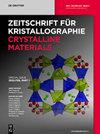Synthesis and structural study of five new phosphoric triamides: interplay between classical and non-classical intermolecular interactions
IF 2.7
4区 材料科学
Q3 CRYSTALLOGRAPHY
Zeitschrift Fur Kristallographie-Crystalline Materials
Pub Date : 2021-11-04
DOI:10.1515/zkri-2021-2050
引用次数: 2
Abstract
Abstract Phosphoric triamides are attractive to investigate because of their extensive applications in various fields, especially in medicine. Five new phosphoric triamides with the main parts [N]P(O)[NH]2 and [C(O)NH]P(O)[N]2 have been structurally analyzed by single crystal MoKα/synchrotron-based X-ray diffraction and characterized by spectroscopic methods (FT-IR and 1H, 13C, 31P NMR). Compounds crystallize in orthorhombic (1 with space group Pnma) and monoclinic (2 (P21/a), 3 (C2/c), 4 (P21/n) and 5 (P21/c)) crystal systems. The asymmetric unit of all structures consists of one phosphoric triamide molecule, except for 1 with one half of molecule. X-ray crystallography data reveal that the molecular architectures constructed by classical N—H … O hydrogen bonds are as 1D linear (building the R21(6)${R}\_{2}^{1}(6)$, C(4) and R22(10)/R21(6)${R}\_{2}^{2}(10)/{R}\_{2}^{1}(6)$ motifs, respectively, for 1–3) or dimeric (the R22(8)${R}\_{2}^{2}(8)$ ring motif for 4 and 5). A detailed investigation of the intermolecular interactions using Hirshfeld surface (HS) analysis illustrates that the H … H, O … H/H … O and C … H/H … C contacts for all compounds, and Cl … H/H … Cl and F … H/H … F contacts for 3–5, are the most significant contributors to the crystal packing. Moreover, based on the calculated enrichment ratios (E), the O … H/H … O contacts including the classical N—H … O hydrogen bonds for all structures are considered as favoured contacts.五种新型磷酸三酰胺的合成与结构研究:经典与非经典分子间相互作用
摘要磷酸三酰胺由于其在各个领域,特别是在医学领域的广泛应用而备受研究。用单晶MoKα/同步加速器X射线衍射方法对五种主要成分为[N]P(O)[NH]2和[C(O)NH]P(O)[N]2的新型磷酸三酰胺进行了结构分析,并用光谱方法(FT-IR和1H,13C,31P NMR)对其进行了表征。化合物结晶为斜方晶系(1,空间群Pnma)和单斜晶系(2(P21/a)、3(C2/c)、4(P21/n)和5(P21/c))。所有结构的不对称单元由一个磷酸三酰胺分子组成,只有1个分子占分子的一半。X射线晶体学数据表明,由经典的N-H…O氢键构建的分子结构为1D线性(构建R21(6)${R}\_{2}^{1}(6)$、C(4)和R22(10)/R21(6)$S{R}/\{2}^(10)/{R}-\{2}^{1}6)$基序,分别用于1-3)或二聚体(R22(8)${R}\_{2}^(8)$环基序用于4和5)。使用Hirshfeld表面(HS)分析对分子间相互作用进行的详细研究表明,所有化合物的H…H、O…H/H…O和C…H/H..C接触,以及3–5的Cl…H/H.Cl和F…H/H·F接触,是晶体堆积的最重要贡献者。此外,基于计算的富集率(E),包括所有结构的经典N-H…O氢键的O…H/H…O接触被认为是有利的接触。
本文章由计算机程序翻译,如有差异,请以英文原文为准。
求助全文
约1分钟内获得全文
求助全文
来源期刊

Zeitschrift Fur Kristallographie-Crystalline Materials
CRYSTALLOGRAPHY-
CiteScore
2.00
自引率
16.70%
发文量
55
期刊介绍:
Zeitschrift für Kristallographie – Crystalline Materials was founded in 1877 by Paul von Groth and is today one of the world’s oldest scientific journals. It offers a place for researchers to present results of their theoretical experimental crystallographic studies. The journal presents significant results on structures and on properties of organic/inorganic substances with crystalline character, periodically ordered, modulated or quasicrystalline on static and dynamic phenomena applying the various methods of diffraction, spectroscopy and microscopy.
 求助内容:
求助内容: 应助结果提醒方式:
应助结果提醒方式:


